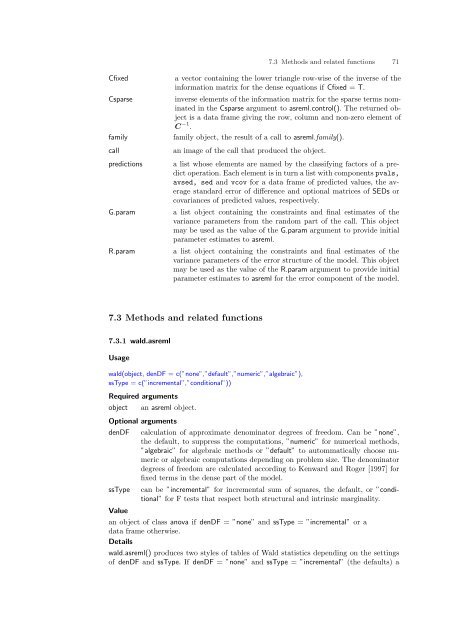ASReml-S reference manual - VSN International
ASReml-S reference manual - VSN International
ASReml-S reference manual - VSN International
- No tags were found...
Create successful ePaper yourself
Turn your PDF publications into a flip-book with our unique Google optimized e-Paper software.
7.3 Methods and related functions 71CfixedCsparsefamilycallpredictionsG.paramR.parama vector containing the lower triangle row-wise of the inverse of theinformation matrix for the dense equations if Cfixed = T.inverse elements of the information matrix for the sparse terms nominatedin the Csparse argument to asreml.control(). The returned objectis a data frame giving the row, column and non-zero element ofC −1 .family object, the result of a call to asreml.family().an image of the call that produced the object.a list whose elements are named by the classifying factors of a predictoperation. Each element is in turn a list with components pvals,avsed, sed and vcov for a data frame of predicted values, the averagestandard error of difference and optional matrices of SEDs orcovariances of predicted values, respectively.a list object containing the constraints and final estimates of thevariance parameters from the random part of the call. This objectmay be used as the value of the G.param argument to provide initialparameter estimates to asreml.a list object containing the constraints and final estimates of thevariance parameters of the error structure of the model. This objectmay be used as the value of the R.param argument to provide initialparameter estimates to asreml for the error component of the model.7.3 Methods and related functions7.3.1 wald.asremlUsagewald(object, denDF = c(”none”,”default”,”numeric”,”algebraic”),ssType = c(”incremental”,”conditional”))Required argumentsobjectan asreml object.Optional argumentsdenDFssTypeValuecalculation of approximate denominator degrees of freedom. Can be ”none”,the default, to suppress the computations, ”numeric” for numerical methods,”algebraic” for algebraic methods or ”default” to autommatically choose numericor algebraic computations depending on problem size. The denominatordegrees of freedom are calculated according to Kenward and Roger [1997] forfixed terms in the dense part of the model.can be ”incremental” for incremental sum of squares, the default, or ”conditional”for F tests that respect both structural and intrinsic marginality.an object of class anova if denDF = ”none” and ssType = ”incremental” or adata frame otherwise.Detailswald.asreml() produces two styles of tables of Wald statistics depending on the settingsof denDF and ssType. If denDF = ”none” and ssType = ”incremental” (the defaults) a
















